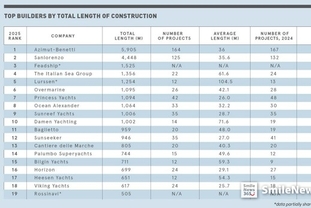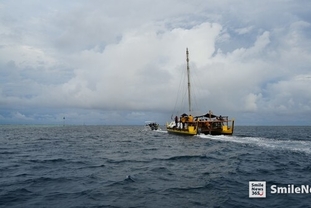BEIJING, Aug. 17, 2025 -- At the dock, a pure electric tugboat lies quietly at a berth. Stepping into the cabin, there is none of the roar or vibration of a traditional fuel-powered tug, only the faint hum of electric currents as the equipment runs.
Crew members are checking the systems, with screens displaying real-time data on energy consumption and operational status. When mooring operations begin, a single press of a switch on the bridge sets the vessel in motion, and within minutes, the tug departs smoothly from the dock to precisely assist a large ship in berthing or unberthing.
Compared with traditional fuel-powered tugboats, the electric model in Lianyungang, the largest port in Jiangsu Province, offers zero emissions and quiet, low vibration operation, greatly improving air quality and crew comfort. They can operate for 1-2 days, meeting the demands of port tug-assist operations, and can be fully recharged within 2-3 hours using high-voltage fast charging at dedicated berths. Thanks to intelligent energy management, they use only one-third of the energy consumed by traditional fuel tugs and require fewer crew members, saving the port about 2-3 million yuan annually in fuel and labor costs.
This is part of China's first all-electric tugboat fleet, a three-vessel lineup that forms a key element of Lianyungang's technological and green transformation to become a modern port of global significance, playing a crucial role in the Belt and Road Initiative (BRI).
On September 13, 2022, a signed article by President Xi Jinping titled "Build on the Past to Make Greater Strides in China-Kazakhstan Relations" was published on the Kazakhstanskaya Pravda newspaper ahead of his state visit to Kazakhstan, the Xinhua News Agency reported. The article noted that at the China-Kazakhstan International Logistics Base in the eastern Chinese port of Lianyungang, products from Kazakhstan set sail for the Pacific Ocean. The China-Europe freight trains are running through Kazakhstan via more routes, making an important contribution to the stability of global industrial and supply chains.
Small port to global hub
Yin Deming, captain of the electric tugboat who has worked at the port for 18 years, has taken a front seat to witness the transformation of Lianyungang from a small port to a global hub.
Compared with traditional fuel-powered tugboats, the electric tugs feature higher automation and simpler operation, Yin told the Global Times as he skillfully adjusted the tug's angle with a simple control stick in the wheelhouse, smoothly guiding it toward an incoming cargo ship.
"In the past, starting the tug required multiple steps and coordination across departments, making it time-consuming and complex. Now, a single command from the bridge starts everything, eliminating the need for on-site manual operations and improving efficiency," Yin said, adding that the time from receiving the operation notice to the tug leaving the dock has been cut from 8-10 minutes to less than 2 minutes.
The electric tugboat is just one example of the changes at Lianyungang.
Xue Xilei, executive deputy general manager of LYG-PSA Container Terminal Co.,Ltd, is well placed to illustrate the transformation of the port. Over the past decades, he has seen it evolve. "About 30 years ago, the port had only about three companies and an annual throughput of 10 million tons... Today it handles more than 300 million tons of cargo per year, with a vibrant cluster of enterprises, and has become a hub of international trade."
The BRI has given Lianyungang a new launching pad.
In 2017, President Xi pointed out in his speech during his state visit to Kazakhstan that the opening of the freight train of China-Kazakhstan cross-border transportation not only brings benefits to China and Kazakhstan but also provides more convenience for transportation and cooperation opportunities for the countries along the "Belt and Road," showcasing the organic integration of the Silk Road Economic Belt and the 21st Century Maritime Silk Road, Xinhua reported.
On the large screen at the dispatch center of the China-Kazakhstan (Lianyungang) Logistics Cooperation Base, information on destinations, origins, and cargo of China-Europe (Central Asia) freight trains between China and Kazakhstan was displayed and updated in real time. And, it provides live video footage of the Horgos Dry Port, known as the "Eastern Gateway."
"Now, transport capacity, train frequency, and operational efficiency have all improved a lot compared to 10 years ago," said Kong Xiangwei, vice general manager of Lianyungang China-Kazakhstan International Logistics Co., Ltd, noting that what once took four hours to load a freight train, can now be done in only two hours, with a maximum daily throughput of seven trains.
The China-Kazakhstan (Lianyungang) Logistics Cooperation Base, which is part of Lianyungang's free trade zone, is only one key aspect of city's broader integration into the BRI.
Since the approval in August 2019, the city's free trade zone has focused on building an Asia-Europe transport hub and promoting cooperation with BRI partner countries, Wang Yunlong, director of the Institutional Innovation Bureau of the Lianyungang Free Trade Zone, told the Global Times.
Although occupying only 0.27 percent of the city's total area, the free trade zone contributes nearly one-third of the city's actual foreign investment utilization, one-fifth of its import and export trade, and one-eighth of newly established enterprises.
Greater connectivity
Besides its role in the BRI, Lianyungang is also strengthening cooperation with many developing countries, helping to promote their high-quality and sustainable development.
Located about 13 kilometers from the port in the Lianyungang Economic Development Zone, a local factory was buzzing with activity. It is producing massive wind power blades over 100 meters long for both domestic and overseas market. The factory now operates seven such blade production lines.
Some steps in the firm's operations are now automated, Qiao Xiaoliang, general manager of Zhongfu Lianzhong Wind Power Blade (Lianyungang) Co., Ltd, told the Global Times, adding that automated processes include trimming, grinding, painting, and transportation.
In recent years, with the promotion of high-quality development of the BRI, the company's wind power blades have gained popularity in overseas market. Taking advantage of its close proximity to Lianyungang Port, the company's export business is expanding quickly. Its products reach countries from Bolivia in South America, to Bosnia and Herzegovina in Europe.
There are currently two factories in Lianyungang producing around 240 blades per month. If production runs smoothly, the capacity could rise to 280 blades, Qiao said.
Another factory also showcases the industrial muscle of this bustling trade city. At Lianyungang Feiyan Blanket Co., Ltd, which produces everything from warp- and weft-knitted blankets to delicate thin velvet throws, only a handful of workers dot the vast factory floor.
"Our level of automation is very high — from the equipment to the production lines, almost everything is developed and manufactured in-house. The current automation rate has reached 70-80 percent," Xu Yingxi, general manager of Lianyungang Feiyan Blanket Co, told Global Times.
The company's products have gained a reputation for high quality in many parts of the world, including BRI partner countries, with business presence in regions such as South Africa and several in South America.
Lianyungang maintains very close ties with many BRI partner countries.
Kong told the Global Times that Lianyungang's advantage lies in its dual role as both a port and a freight train hub, making it a key international logistics hub connecting Japan, South Korea, Southeast Asia, and Central Asia, said Kong. Transported cargo includes used cars, auto parts, and other high value-added products.
Resilient trade
From Lianyungang's sea port and freight-train logistics hub to its manufacturing facilities, the city is promoting global cooperation with an open and forward-looking mindset. The efforts underscore Lianyungang's rising prominence as a promising freight trade hub.
In the first half of 2025, Lianyungang's foreign trade reached 119.22 billion yuan, with exports totaling 26.27 billion yuan, marking a year-on-year increase of 17.9 percent, according to data from China's General Administration of Customs.
Lianyungang has made strides in propelling foreign trade growth, while continuously expanding a network of international partners. Trade with the BRI partner countries has grown by over 20 percent annually for four consecutive years, surpassing 100 billion yuan for the first time in 2024 and setting a historic high, according to Lianyungang Municipal Government.
This year, Lianyungang has witnessed many "firsts."
In July, the Xin Xin Hai 1, a cargo ship, set sail from Lianyungang, marking the first voyage of the China-Russia Arctic "Ice Silk Road" to Arkhangelsk.
In May, the Anji Ansheng, the world's largest car carrier built by China, left Lianyungang on its maiden trip to Europe, showcasing China's automotive sector strength.
"While China is opening more and more shipping routes and our network of foreign trade partners is expanding, our port is leveraging the momentum to continue building, transforming, and upgrading," Xue said.
Although unilateralism and protectionism have brought short-term pressures to global trade, Xue expressed confidence in the resilience and strength of Chinese manufacturing and trade.
He noted that exports to ASEAN and other markets have continued to grow, with trade becoming more active under the RCEP framework. For example, cold-chain imports at Lianyungang are on the rise, driven by growing demand for fruit and frozen products from Southeast Asian countries.
Looking into the future, Xue noted that the port is embracing automation, which will unleash greater potentials.
"The automated terminal area has already broken ground, though full automation has yet to be achieved, and work is progressing steadily," Xue said. Pointing to a 90,000-square-meter space now under construction, he described the tall quay cranes and blue yard cranes in view, noting that they will eventually operate without human intervention, consolidating Lianyungang's position as a major trade hub.













